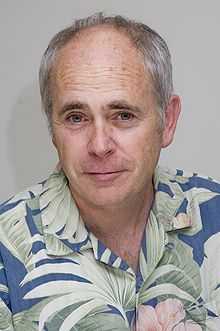Richard Anthony Jefferson
| Richard Jefferson | |
|---|---|
 Richard Jefferson, 2010 | |
| Born | Richard Anthony Jefferson |
| Institutions | |
| Alma mater | |
| Thesis | DNA Transformation of Caenorhabditis elegans devleopmetn and Application of a New Gene Fusion System (Cloning, Chimeric, Sequence) (1985) |
| Known for | |
|
Website www | |
Richard Anthony Jefferson (born 1956) is an American-born molecular biologist, who developed the reporter gene system GUS,[3] a widespread molecular technique. In 2003 he was named by Scientific American as one of the 50 most influential technologists in the world.[4][5]
Education
Born in Santa Cruz, California, Jefferson studied at the University of California, Santa Barbara at the College of Creative Studies, and obtained his BA (Molecular Genetics) in 1978. He then moved to the University of Colorado Boulder for his Ph.D., where he first developed the GUS reporter system.[3]
Career
As a postdoctoral researcher he worked at the Plant Breeding Institute in Cambridge, England: there he adapted the GUS assay for the use in plants.[3] His GUS system was a breakthrough in plant molecular sciences, useful for the development of efficient transformation methods for crop plants. During his postdoc in Cambridge, he also managed the world's first field release of a transgenic food crop (June 1, 1987).[6]
In 1989, Jefferson joined the Food and Agriculture Organization of the United Nations (FAO) as senior scientist, the first molecular biologist in this position. Since then he traveled, worked and taught in many developing countries. He left the organization in 1991, when he founded a private research institution, CAMBIA. His non-profit company moved later to Australia, due to the involvement in the Asian rice biotechnology programs of the Rockefeller Foundation.[6]
Jefferson is also considered a global leader in social entrepreneurship and is a Schwab Fellow of the World Economic Forum.[7]
In 2009, with new support from the Bill & Melinda Gates Foundation, Jefferson moved with Cambia to the [Queensland University of Technology] (QUT) in Brisbane, Australia, as Professor of Science, Technology & Law, to become Director of the Initiative for Open Innovation.[8]
Richard Jefferson is known also for his expertise regarding intellectual property. The BiOS Initiative, which he founded in 2005, is active in the promotion of open source biology of a similar philosophy to that in informatics.[9] In 2013 Cambia launched The Lens[10] a free and open source patent searching and analysis tool, replacing the older Patent Lens.
References
- ↑ Jefferson, R. A. (1987). "Assaying chimeric genes in plants: The GUS gene fusion system". Plant Molecular Biology Reporter 5 (4): 387. doi:10.1007/BF02667740.
- ↑ Jefferson, R. A. (1989). "The GUS reporter gene system". Nature 342 (6251): 837–8. doi:10.1038/342837a0. PMID 2689886.
- ↑ 3.0 3.1 3.2 Jefferson, R. A.; Kavanagh, T. A.; Bevan, M. W. (1987). "GUS fusions: Beta-glucuronidase as a sensitive and versatile gene fusion marker in higher plants". The EMBO journal 6 (13): 3901–7. PMC 553867. PMID 3327686.
- ↑ Scientific American Website: The 2003 Scientific American 50 List of Winners , URL accessed on 30 May 2006
- ↑ Richard Anthony Jefferson's publications indexed by Google Scholar, a free service provided by Google
- ↑ 6.0 6.1 Jefferson, R. (2006). "Science as Social Enterprise: The CAMBIA BiOS Initiative". Innovations: Technology, Governance, Globalization 1 (4): 13. doi:10.1162/itgg.2006.1.4.13.
- ↑ http://www.schwabfound.org/sf/SocialEntrepreneurs/Profiles/index.htm?sname=129191
- ↑ http://openinnovation.org
- ↑ Herrera, S. (2005). "Profile: Richard Jefferson". Nature Biotechnology 23 (6): 643. doi:10.1038/nbt0605-643.
- ↑ http://www.lens.org
|